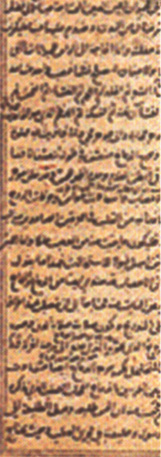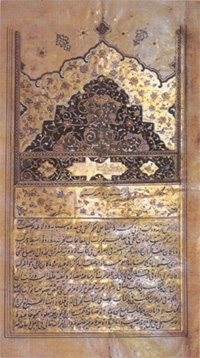|
 It
has often been suggested that Christianity
brought about the end of science. Whether
or not this is true, the Greeks’
inquisitiveness, for one, might have been
a threat for the forming faith.
Coincidence or not, as Christianity grew
in Europe, science declined and remained
suppressed for about one thousand years.
During this inactive period in Europe, the
vast Arab empire embraced science and its
learned men did much for the advancement
of world progress. It
has often been suggested that Christianity
brought about the end of science. Whether
or not this is true, the Greeks’
inquisitiveness, for one, might have been
a threat for the forming faith.
Coincidence or not, as Christianity grew
in Europe, science declined and remained
suppressed for about one thousand years.
During this inactive period in Europe, the
vast Arab empire embraced science and its
learned men did much for the advancement
of world progress.
One
field in which Arabic scholars excelled
was biology, which from the 3rd
until the 11th century was
essentially an Arab science. Chemistry
was another science in which the Arab
world took the lead. Most of the
chemists of the time were in fact
alchemists, busy in the pursuit of the
philosopher’s stone, which would
supposedly turn common metals into gold.
The philosopher’s stone was
never discovered. However, the efforts
spent in its search were not futile.
Numerous chemical substances were named
and characterized, some of which were
found to have medical value. Many drugs
now in use are of Arab origin, as are the
processes of distillation and sublimation.
One of the greatest
Arab contributors to science is Abu Ali
Al-Husayn ibn Abd Allah Ibn Sina, who
became one of the most influential
philosophers and physicians not only in
the Muslim world, but also on a global
level.
Ibn Sina’s early life
Born in 980 in Bukhara, Iran, Ibn Sina
(today also famous as Avicenna) was
tutored by his father in his forming
years. Ibn Sina’s father was a leader of
the Ismailiyah – a religious Islamic
society, which based its ideas on a type
of Neo-Platonism. Although young Ibn Sina
never followed his father’s convictions,
he benefited extensively from the fact
that many learned men often gathered to
converse and debate in his father’s house.
When he was only ten years old, Ibn Sina
had already memorized the Quran, many
Arabic poems and other literary works.
Ibn Sina’s early thirst for
knowledge soon took him to prominent
teachers of logic and metaphysics. By the
time he was eighteen years of age, Ibn
Sina found his tutors not needed any more
and went on to carry his studying by
himself. He acquired profound knowledge in
medicine, Islamic Law, and metaphysics.
Particularly helpful in his
intellectual development was his gaining
access to the rich royal library of the
Samanids- the first great native dynasty
that arose in Persia after the Arab
conquest. Ibn Sina was granted access to
the great library after he successfully
cured Prince Nooh Ibn Mansoor of the
Samanid dynasty of an illness in which all
the well-known physicians of the time had
given up hope.
By his early twenties, the young man had
become a popular and highly respected
physician. He was also given an
administrative post and soon wrote his
first book. Suddenly though, the whole
pattern of the young man’s life was about
to change. His father died, the Samanid
house was defeated and he began a period
of wandering and turmoil, which was to
mark the rest of his life with the
exception of a few unusual periods of
tranquility.
 Destiny has plunged Ibn Sina into one of
the tumultuous periods of the history of
Persia. But being exceptionally gifted, he
managed to carry on with his intellectual
pursuits without being influenced by
outward disturbances.
Destiny has plunged Ibn Sina into one of
the tumultuous periods of the history of
Persia. But being exceptionally gifted, he
managed to carry on with his intellectual
pursuits without being influenced by
outward disturbances.
After wandering around
central Persia and failing to find the
necessary support and peace of mind to
continue with his studies, he then moved
to Hamadan, in west central Persia, where
the Shams ad-Dawlah was ruling. He cured
the ruler of colic and became court
physician and a vizier. At one point, a
mutiny of soldiers against him caused his
dismissal and imprisonment, but
subsequently the Shams ad-Dawlah, being
again attacked by the colic, summoned him
back with an apology and reinstated him.
The scholar’s life at this time was very
strenuous. During the day he was busy
fulfilling his duties as a physician and
administrator, while a great deal of the
night was passed in lecturing and
dictating notes for his books. Students
would regularly gather in his home and
would read parts of his great book, Al-Qanun
fi al-Tibb, which he had started
working on.
Al-Qanun fi al-Tibb
, also known as the Canon of Medicine,
is the most famous single book in the
history of medicine in both East and West.
It is a study encompassing and
systemathising the achievements of Greek
physicians as well as the entire medical
knowledge available from Muslim sources.
It is divided into five books. The first
contains a general expose on the human
body, sickness, health and general
treatment and therapeutics. The second
book contains the Pharmacology of herbs
and a section on experimentation in
medicine. The third book is all about the
subject of special pathology. The fourth
book follows with its famous treatise on
fevers and with a treatise on signs,
symptoms, diagnostics and prognostics,
minor surgery, tumors, wounds, fractures
and bites, as well as a chapter on
poisons. The fifth book contains the
pharmacopoeia, with a description of some
760 drugs.
In addition to bringing together the then
available knowledge, the book is rich with
the author's original findings. Ibn Sina’s
important contribution includes such
advances as recognition of the contagious
nature of phthisis and tuberculosis,
distribution of diseases by water and
soil, and interaction between psychology
and health. The first study to describe
meningitis and to make rich contributions
to anatomy, gynaecology and child health,
Al-Qanun fi al-Tibb became a
popular classic and was used at many
medical schools until as late as 1650.
In 1022 Shams ad-Dawlah died and Ibn Sina
found himself in a rather uncomforting
environment. This resulted in a period of
difficulty, which culminated into
imprisonment. Luckily, Ibn Sina found a
way to flee to Isfahan about 250 miles
south of Tehran. Accompanied by a small
entourage, Ibn Sina reached Isfahan and
decided to settle down. There he spent the
last 14 years of his life in relative
peace. He concluded his great work on his
al-Qanun as well as on Kitab al-Shifa',
his other monumental work.
Probably the largest work of its kind ever
written by one man, Kitab al-Shifa'
(The Book of Healing) embodies a
vast field of knowledge and medical
experience. Ibn Sina divided philosophy,
which he claimed to be the general name
for all knowledge, into two major parts.
One was speculative philosophy and the
other one was practical philosophy.
Speculative philosophy was divided into
four parts itself, which were
interestingly categorised. They were
physics - the inferior science,
mathematics – considered to be the middle
science, and metaphysics and theology -
the superior science. Practical philosophy
on the other hand was divided into ethics,
economics, and politics. These divisions
are of essential importance on account of
their influence on the arrangement of
sciences in the schools where the
philosophy of Ibn Sina preceded the
introduction of Aristotle’s works.
Kitab al-Shifa'
is also Ibn Sina’s most important work as
far as mathematics is concerned, as one of
the book’s four parts is solely dedicated
to the subject. Ibn Sina divided
mathematics into another four branches.
These he classified as geometry,
astronomy, arithmetic, and music, and he
then subdivided each of these topics even
further. Geometry he subdivided into
geodesy, static, kinematics, hydrostatics,
and optics. Astronomy he subdivided into
astronomical and geographical tables, and
the calendar. Arithmetic was made of the
components of algebra, and Indian addition
and subtraction. And, finally, music Ibn
Sina saw as a whole made up of the
subdivisions of the different musical
instruments.
During military campaigns Ibn Sina was
expected to accompany his patron, but he
still carried on with his writing. It was
on one of these military campaigns in 1037
that Ibn Sina fell ill. Despite his
attempts to cure himself, he could not
prevent the development of the sickness
and soon died.

Ibn Sina’s influence
Throughout his life, Ibn Sina's wrote
about 450 works of which only around 240
have survived. From his works in existence
today, 150 are on philosophy while 40 are
devoted to medicine, the two fields in
which he contributed most. He also wrote
on psychology, geology, mathematics,
astronomy, and logic.
All of his books and treatises were
written in Arabic, with the exception of
two works, which were written in Farsi –
Ibn Sina’s native language. The first one
is the `Daneshnameh-e-Alai' (Encylopedia
of Philosophical Sciences), the second - a
small treatise on the pulse, which later
became quite famous.
In the 12th century Ibn Sina's Kitab al-Shifa'
was translated partially into Latin. The
complete al-Qanun also appeared in Europe
around this time. These translations and
others spread his thought far and wide. In
medicine al-Qanun became the undisputed
medical authority for several centuries,
granting the scholar a place of honor
equaled only by the early Greek physicians
Hippocrates and Galen. The fame of the
book was such that its author became known
as the "Prince of Physicians" in the West.
Also known as al-Sheikh al-Rais (Leader
among the wise men), a title given to him
by his students, Ibn Sina contributed
significantly to the field of astronomy.
He made astronomical observations while at
Isfahan and later - at Hamadan. These
studies produced a number of deductions,
which proved to be true centuries later.
For example, he observed Venus as a spot
against the surface of the Sun and
correctly deduced that Venus must be
closer to the Earth than the Sun. He also
invented an instrument for observing the
coordinates of a star.
In physics, his contribution comprised the
study of different forms of energy - heat,
light and mechanical energy, as well as
such concepts as force, vacuum and
infinity. He made the important
observation that if the perception of
light is due to the emission of some sort
of particles by the luminous source, the
speed of light must be finite. He
propounded an interconnection between time
and motion, and also made investigations
on specific gravity and used an air
thermometer.
He also contributed to the field of music and is the reported
author of Persian quatrains and short
poems:
"Up from Earth's Centre through the
Seventh Gate I rose, and on the Throne of
Saturn sate, And many a knot unravelled by
the Road, But not the Master-knot of Human
Fate."
His treatise on minerals was one of the
main sources of geology of the Christian
encyclopaedists of the thirteenth century.
Ibn Sina's major contributions are in
philosophy. Although he found Aristotle’s
teachings too hard to incorporate into
practical knowledge, he wrote numerous
treaties discussing his teachings. Ibn
Sina’s philosophy synthesises Aristotelian
tradition, Neoplatonic influences and
Muslim theology. In Latin translations,
his works influenced many Western
philosophers and scholars, most notably
Thomas Aquinas. |
